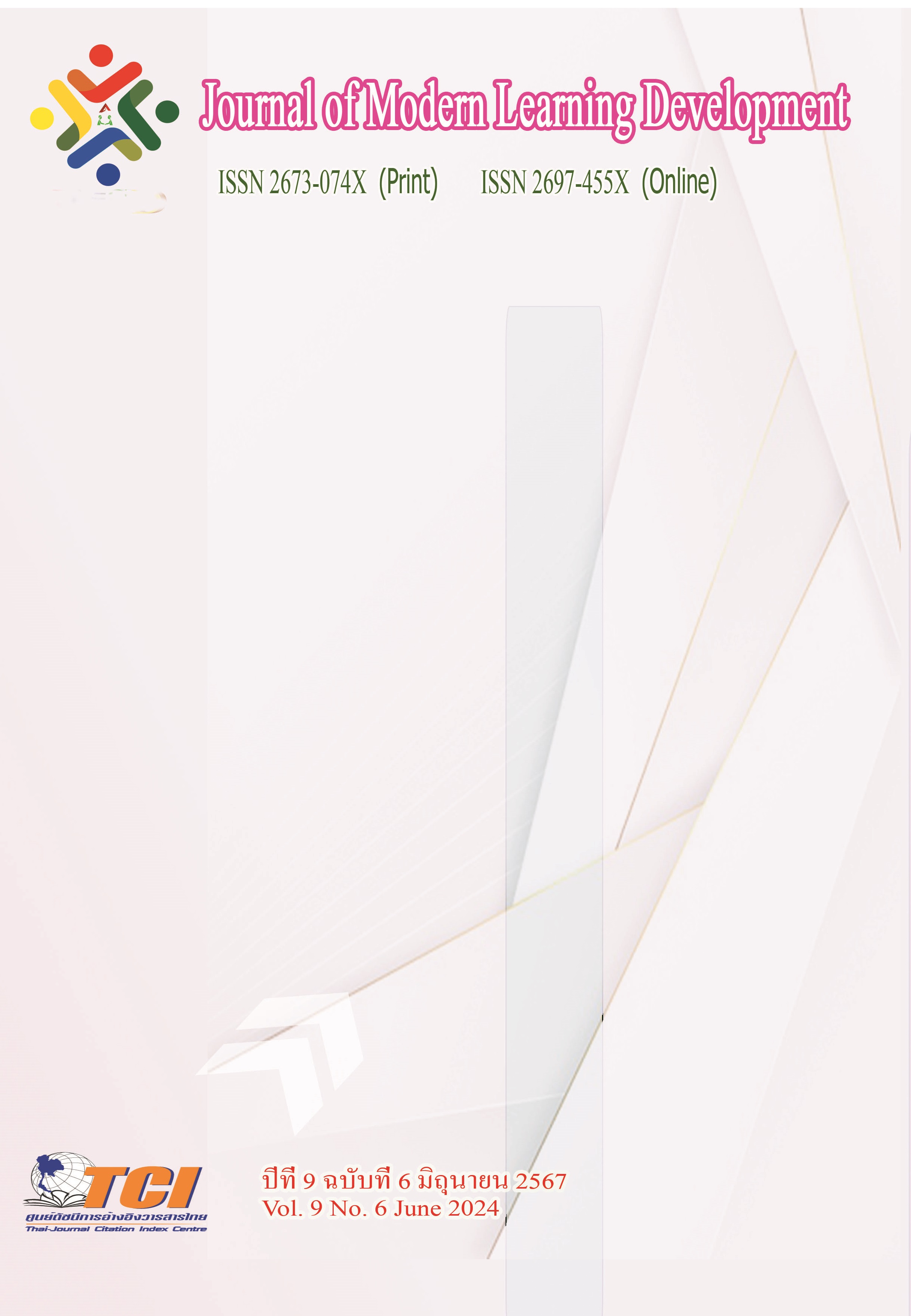The Development of Nonfiction Writing Ability of Mathayomsuksa 4 Students by Using Genre-Based Learning Combined with Round Table Techniques
Main Article Content
Abstract
The development of non-fiction writing ability of mathayomsuksa 4 students by using genre-based learning combined with roundtable techniques is experimental research which aims to 1) study the development of non-fiction writing of mathayomsuksa 4 students after learning by genre-based learning combined with roundtable techniques and 2) study the mathayomsuksa 4 students’ opinion toward genre-based learning combined with roundtable techniques. The sample consisted of 31 students from mathayomsuksa 4/131 who are studying writing subject TH31201, semester 1 in academic year 2023 at Patumwan Demonstration School, obtained by cluster sampling using the classroom as a random unit. The instruments used were: 1) the four non-fiction writing teaching plans; 2) the nonfiction writing ability test; and 3) a questionnaire used to study students’ opinions about learning. The data was analyzed by mean (M), standard deviation (SD), and repeated measures ANOVA.
The research results: 1) the non-fiction writing ability of mathayomsuksa 4 students after learning by genre-based learning combined with roundtable techniques showed that mathayomsuksa 4 students’ non-fiction writing ability increased in every measurement, statisticallysignificant at the .05 level; and 2) the opinions of mathayomsuksa 4 students towards genre-based learning combined with roundtable techniques showed that mathayomsuksa 4 students’ opinions towards genre-based learning combined with roundtable techniques were at the highest level.
Article Details
References
ฉวีวรรณ คูหาภินันทน์. (2558). เทคนิคการเขียนสารคดี. วารสารสารสนเทศ. 14 (2), 1-6.
ถวัลย์ มาศจรัส. (2544). ตัวอย่างการเขียนเรื่องบันเทิงคดีและสารคดีสำหรับเด็ก. กรุงเทพมหานคร: ธารอักษร.
ธัญญา สังขพันธานนท์. (2556). การเขียนสารคดีภาคปฏิบัติ. (พิมพ์ครั้งที่ 3). นนทบุรี: มาตาการพิมพ์.
นภดล จันทร์เพ็ญ. (2557). หลักการใช้ภาษาไทย. กรุงเทพมหานคร: เจเนซิส มีเดียคอม.
บังอร ฤทธาภรณ์. (2542). การเขียนอย่างมีประสิทธิผล. กรุงเทพมหานคร: ภาควิชาภาษาไทยและภาษาตะวันออก มหาวิทยาลัยศรีนครินทรวิโรฒ.
พวงรัตน์ ทวีรัตน์. (2538). วิธีวิจัยทางพฤติกรรมศาสตร์และสังคมศาสตร์. กรุงเทพมหานคร: ม.ป.ท.
ภาสกร เกิดอ่อน และคณะ. (2556). หลักภาษาและการใช้ภาษาไทย ม.5. กรุงเทพมหานคร: อักษรเจริทัศน์.
วรรณี โสมประยูร. (2553). เทคนิคการสอนภาษาไทย. กรุงเทพมหานคร: ดอกหญ้าวิชาการ จำกัด.
วัชรพล วิบูลยศริน. (2556). การพัฒนารูปแบบการเรียนการสอนแบบผสมผสานตามแนวการสื่อสารแบบมีส่วนร่วมโดยใช้เทคนิคการเขียนรอบวงบนสื่อสังคมเพื่อเสริมสร้างความสามารถด้านการเขียนวิพากษ์เชิงสร้างสรรค์สำหรับนักศึกษาปริญญาตรี. วิทยานิพนธ์ครุศาสตรดุษฎีบัณฑิต. สาขาเทคโนโลยีและสื่อสารการศึกษา. บัณฑิตวิทยาลัย: จุฬาลงกรณ์มหาวิทยาลัย.
ศุภวรรณ สัจจพิบูล. (2553). การพัฒนารูปแบบการเรียนการสอนโดยบูรณาการแนวการเขียนแบบเน้นกระ บวนการ เนื้อหาและประเภทงานเขียน เพื่อส่งเสริมความสามารถในการเขียนเชิงวิชาการและการคิดอย่างมีวิจารณญาณของนิสิตนักศึกษาระดับปริญญาบัณฑิต. วิทยานิพนธ์ปรัชญาดุษฎีบัณฑิต.สาขาหลักสูตรและการสอน. บัณฑิตวิทยาลัย: จุฬาลงกรณ์มหาวิทยาลัย.
สนิท สัตโยภาส. (2546). ภาษาไทยเพื่อการสื่อสารและสืบค้น. กรุงเทพมหานคร: ธารอักษร.
สำนักวิชาการและมาตรฐานการศึกษา. (2551). ตัวชี้วัดและสาระการเรียนรู้แกนกลาง กลุ่มสาระการเรียนรู้ภาษาไทย ตามหลักสูตรแกนกลางการศึกษาขั้นพื้นฐาน. ออนไลน์. สืบค้นเมื่อ 20 มีนาคม 2566. แหล่งที่มา http://academic.obec.go.th/newsdetail.php?id=75
สุธีรา นาถึง. (2560). การพัฒนาการเขียนชี้แจงตามแนวคิดอรรถฐาน: กรณีศึกษานักเรียนชั้นมัธยมศึกษาปีที่ 4. วิทยานิพนธ์การศึกษามหาบัณฑิต. สาขาภาษาศาสตร์การศึกษา. บัณฑิตวิทยาลัย: มหาวิทยาลัยศรีนครินทรวิโรฒ.
เสาวลักษณ์ รัตนวิชช์. (2550). การสังเคราะห์ผลวิจัยของนิสิตระดับบัณฑิตศึกษาของมหาวิทยาลัยในประเทศไทยเกี่ยวกับการจัดการเรียนการสอนภาษาไทยและภาษาอังกฤษแบบมุ่งประสบการณ์ภาษา. กรุงเทพมหานคร: คณะศึกษาศาสตร์ มหาวิทยาลัยศรีนครินทรวิโรฒ.
อัจฉรา ชีวพันธ์. (2553). กิจกรรมการเขียนสร้างสรรค์ในชั้นประถมศึกษา. (พิมพ์ครั้งที่ 11). กรุงเทพมหานคร: จุฬาลงกรณ์มหาวิทยาลัย.
อินทร์วุธ เกษตระชนม์. (2551). ผลของการสอนการเขียนตามแนวคิดอรรถฐานที่มีต่อความสามารถในการเขียนเรียงความเชิงสร้างสรรค์และความคิดสร้างสรรค์ของนักเรียนชั้นมัธยมศึกษาปีที่ 5. วิทยา นิพนธ์ครุศาสตรมหาบัณฑิต. บัณฑิตวิทยาลัย: จุฬาลงกรณ์มหาวิทยาลัย.
Browne. (1970). The Art of Nonfiction. Toronto: Macmillan.
Carstens, A. (2009). The effectiveness of genre-based approaches in teaching academic writing: subject-specific versus cross-disciplinary emphases. Doctoral Dissertation. College: University of Pretoria, South Africa.
Christie, F. (1989). Curriculum genres in early childhood education: a case study in writing development. Doctoral Dissertation. College: University of Sydney.
Flora, Cahyadi, D. and Sukirlan, M. (2020). A modified roundtable technique based on proc ess approach to promote the students’ writing achievements in foreignlan guage se tting. International Journal of Education and Practice. 8 (1), 149-157.
Hyland, K. (2007). Genre and Second Language Writing. Michigan: The University of Michigan Press.
Jantrasakul, P. (2016). Genre-Based Writing Instruction: Theme Analysis of ELF Expo sito ryEs says. Journal of Humanities and Social Sciences Mahasarakham University. 35 (3), 96–104.
Kagan, S. and Kagan, M. (2009). Kagan Cooperative Learning. USA: Kagan Publishing.
Nordin, S. and Mohammad, N. (2017). The best of two approaches: process/genre-based approach to teaching writing. The English Teacher. 35, 75-85.
Parmawati, A., Santoso, I., and Yana. (2020). Improving students’ writing skill throughhro un dtable technique. ELTIN Journal:Journal of English language teaching inIndonesia. 8 (2), 104-111.
Rundle, S. and Elaine, L. (1992). A study of the effects of interactive writing on reading comprehension in fifth-grade. Doctor of Education. College: University of Massachusetts.
Ueasiriphan T. and Tangkiengsirisin S. (2019). The Effect of Genre-Based Teaching on Enha ncement of Thai Engineers’ Technical Writing Ability. International Journal of Instr uction. 12 (2), 723-728.
Vygotsky, L. S. (1978). Interaction between learning and development. Readings on the De velopment of Children. 23 (3), 34–41.
Widodo, H. P. (2008). Process-based academic essay writing instruction in an EFL. BAHASA DAN SENI. 36 (1), 101–111.

